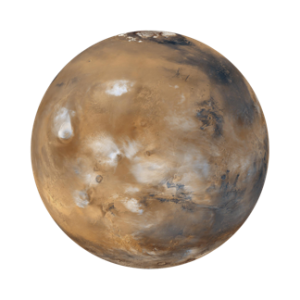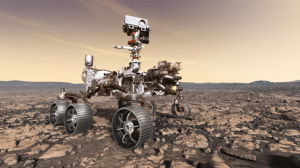Kids are naturally curious, wondering about everything around them, and growing in their journey of figuring out life. Each youth comes into an afterschool program with a unique background and experience – and that is reflected in their own story, perspective, and skills. In afterschool, kids can have experiences where they are guided to deepen their curiosity, develop open communication, make careful and thoughtful observations of the world around them, and learn to work with others as a team. Aren’t these values and skills so important and needed in the world today?
It all starts with “I wonder…” – a question, a yearning to know more. Then, an idea for how to go about answering the question, and a way to test that idea. And a way to understand and show your results – the scientific process.
Scientists and engineers conceive space missions that can answer questions about planets, moons, asteroids, and beyond. In places where it is not safe for humans to explore, NASA depends on robotic missions that can retrieve, analyze, and even return data and samples to Earth for studying. Each person on a mission team plays an important role, bringing their experience and perspective.
Was there ever life on Mars? Where did that comet from? Will an asteroid come close to the Earth? What’s in the ocean that’s underneath the ice on one of Jupiter’s moons? Why is the Earth so different from Venus?
The possibilities are endless!
But which mission is the most compelling? Which team has the best capabilities to make their mission a success? When choosing a destination from all the possibilities to explore, NASA has to consider these questions.

In NASA’s “Strange New Planet” enrichment activity, your youth can contribute their perspective and interests to a spacecraft mission team, while learning to think like scientists and engineers in pursuing answers to the many questions that exist in our solar system. Afterschool leaders don’t need to know the answers – their role is to guide students as they make careful observations, capture and explain what they observe, and finally use it to ask and answer questions. They will guide students to build teamwork skills, ensuring each student’s voice is heard and helping them contribute with their strengths through their role on the team.
“Strange New Planet” asks kids “what if a new world has been discovered? How will you bring your talents to help guide the questions that will be asked of it? What are the most important things to look for? How will you present a solid case to convince NASA that your mission is selected amongst all the others? Why do we need to better know this new world?”

This activity gives kids a chance to build and apply their skills, in the context of how NASA does an actual exploration of the planets in our solar system, and connect them to real-world space exploration going on today such as the Mars 2020 mission.
Earlier robotic missions to Mars have unearthed evidence that liquid water once flowed on Mars – and may still exist under the ice at its poles. Does this mean there were once places on Mars where the conditions were right to support life? Can we find signs of past microbial life? Mars 2020 is the next step of Mars exploration, examining the Martian surface and gathering samples that might help answer these questions. Follow the mission and its launch in summer 2020: https://mars.nasa.gov/mars2020/
Check out these stories of interns who have been using their unique background and dreams to contribute to space exploration at JPL: https://www.jpl.nasa.gov/edu/news/column/meet-jpl-interns/
With growth and guidance, your youth can gain skills to make their own unique contribution to the world!
Instructions for Strange New Planet
Materials
Planets can be made from a combination of materials — modeling clay, Playdoh©, Styrofoam© balls, plastic balls, or rounded fruit (pumpkins, oranges, etc.) Add visual variations — small stickers, sequins, candy, marbles, cotton balls, toothpicks, or anything small and interesting. Add smell using — scent stickers, spices such as cloves, vinegar, perfume, or other scents. Add a small moon and/or cotton for the atmosphere. Use a black or dark cloth to drape over planets. Viewer tubes for each team of 3-4: Made of rolled paper or cardboard tubes with one blue cellophane square 5 by 5 inches attached at one end with a rubber band.
Set-Up
A) Making a Planet: Make three planets (three allows for multisensory observations). Decorate the planets with beads, stickers, scents, etc., to make the object interesting to observe. Some of these materials should be placed discreetly so that they are not obvious upon brief or distant inspection. Some suggestions for features are: Create clouds by using cotton and glue, carve chan-nels, attach a grape using a toothpick (to make moons or orbiting satellites), affix small stickers or embed other objects into the planet, apply scent sparingly to a small area. To one planet, attach something that depicts life or is alive, e.g., butterfly stickers or cloves.
B) Position the Planets: Place planets on a stool or pedestal and cover with cloth — participants should be about 30 feet away from planets, with a clear viewing path. Participants can construct viewers out of loose-leaf paper by rolling the shorter side into a tube (can also use a paper towel roll.) These viewers should be used whenever observing the planet.
Procedure
1) Objective: Brief participants on their task — to explore a strange new planet. At each step, they will formulate new questions to answer: they will remotely explore the new planets, report the data they gathered, and then form questions they can help answer with the next exploration step. The missions gather progressively detailed information.
2) Pre-Launch Reconnaissance: This step simulates Earth-bound observations. Arrange participants in teams of 3 or 4 at one end or side of the room — this is Mission Control. Each participant has a role: observer, recorder, and scientist(s). To simulate Earth’s atmosphere, a blue cellophane sheet is placed at end by a rubber band. This represents Earth’s atmosphere and a deterrent to clear observations from Earth. Remove the cloth covering the planets. The observer ONLY looks at the planet(s) using their viewers for 1 minute, while others turn their backs. Replace the cloth. At this point, all the observations will be visual and will include color, shape, texture, and position. (Ask participants to identify what the blue cellophane represents.) Allow time for discussion and to start forming questions for the next mission.
3) The Fly-by: The observer (ONLY) from each team will have a turn at walking quickly past one side of the planet (the other side remains draped under cloth). A distance of 5 feet from the planet needs to be maintained. The observers reconvene with their teams at the sides of the room (Mission Control). Replace cloth over the planet once all the fly-bys have taken place. Teams discuss what data they gathered, what they learned that’s new, and what they will look for on the next orbit mission.
4) The Orbiter: Each observer takes two orbits (circle) of the planet at a distance of 2 feet. They observe distinguishing features and report their data back at Mission Control. Teams discuss their landing expedition to the planet’s surface. Plans should include the landing spot and features to be examined.
5) The Lander: Each observer approaches their landing site and marks it with a push-pin (or masking tape if the planet will pop using a pin.) Team members take turns observing the landing site with the viewers. The field of view is kept constant by team members aligning their viewers with the push-pin located inside and at the top of their viewers. Within the field of view, students enact the mission plan. After 5 minutes, the team returns to Mission Control to discuss and record their findings.
6) Sample Return: After all teams have shared their data from the landing sites, allow the group as a whole to discuss possible sites where a sample could be taken and returned to Earth laboratories. Either allow each team to take one very small sample (tiny pinch) or have the group decide on one tiny sample from each planet. Sample return missions are very expensive and must be carefully informed by all the previous mission data. Examine and discuss the samples.
For breakfast, I had a veggie egg scramble and English Breakfast tea with milk.
Author: @leslielowes
